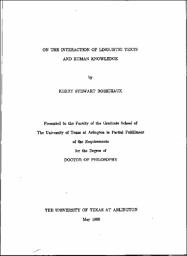
ATTENTION: The works hosted here are being migrated to a new repository that will consolidate resources, improve discoverability, and better show UTA's research impact on the global community. We will update authors as the migration progresses. Please see MavMatrix for more information.
Show simple item record
| dc.contributor.author | Robichaux, Kerry Stewart | |
| dc.date.accessioned | 2020-10-09T15:08:38Z | |
| dc.date.available | 2020-10-09T15:08:38Z | |
| dc.date.issued | 1986-05 | |
| dc.identifier.uri | http://hdl.handle.net/10106/29484 | |
| dc.description.abstract | This study examines some aspects of the interaction of linguistic texts and human knowledge. The quest for greater context in linguistics suggests the focus of this study, viz., the effect of a text on the knowledge of its receiver. A practical problem arises in a study of this sort, however, viz., how should knowledge be represented so that the effects a text has on it can be identified and analyzed? One of the notions employed in the field of artificial intelligence, i.e., the notion of frames, is applied to the problem. In essence, then, this study shows the possible relationships between texts and knowledge as represented in frames. This study makes contributions to two related fields: textlinguistics and ESL/EFL reading methodology. For the field of textlinguistics this study offers a feasible approach to text analysis that takes interaction with human knowledge into account. The approach presented here is one that seeks to identify sections of a text which participate in one of six text-frame relationships proposed. Further, the instances of text-knowledge interaction are shown to support the linguistic structure of a text. A detailed analysis of an English short story and less detailed analyses of shorter texts are is presented and the claims of this study are demonstrated. This study also offers an ESL/EFL methodology for teaching the reading of texts that contain difficult background knowledge. The reasons for the difficulty are explored and suggested solutions current in the field are reviewed and evaluated. The methodology presented is built upon the types of text-knowledge interaction discussed in this study. The reading teacher is advised to look for text-knowledge relationships in the text to be presented and to determine their relevancy to reading comprehension. Important knowledge structures, as well as less important ones occurring in the structurally significant places in the text, should be pre-taught. Examples are provided to help clarify the suggested method. This study ends with some philosophical considerations on a few points raised in the preceding chapters. Specifically, questions concerning authorial intention and concerning language and the mind are considered. | en_US |
| dc.language.iso | en_US | en_US |
| dc.publisher | University of Texas at Arlington | en_US |
| dc.subject | Language | |
| dc.subject | Literature and linguistics | |
| dc.title | ON THE INTERACTION OF LINGUISTIC TEXTS AND HUMAN KNOWLEDGE | en_US |
| dc.type | Dissertation | en_US |
| thesis.degree.department | Humanities | |
| thesis.degree.name | Doctor of Philosophy in Humanities | |
Files in this item
- Name:
- On the Interaction of Linguistic ...
- Size:
- 9.231Mb
- Format:
- PDF
- Description:
- PDF
This item appears in the following Collection(s)
Show simple item record


